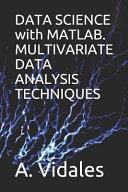
Matrix-Based Introduction to Multivariate Data Analysis
This book enables readers who may not be familiar with matrices to understand a variety of multivariate analysis procedures in matrix forms. Another feature of the book is that it emphasizes what model underlies a procedure and what objective function is optimized for fitting the model to data. The author believes that the matrix-based learning of such models and objective functions is the fastest way to comprehend multivariate data analysis. The text is arranged so that readers can intuitively capture the purposes for which multivariate analysis procedures are utilized: plain explanations of the purposes with numerical examples precede mathematical descriptions in almost every chapter. This volume is appropriate for undergraduate students who already have studied introductory statistics. Graduate students and researchers who are not familiar with matrix-intensive formulations of multivariate data analysis will also find the book useful, as it is based on modern matrix formulations with a special emphasis on singular value decomposition among theorems in matrix algebra. The book begins with an explanation of fundamental matrix operations and the matrix expressions of elementary statistics, followed by the introduction of popular multivariate procedures with advancing levels of matrix algebra chapter by chapter. This organization of the book allows readers without knowledge of matrices to deepen their understanding of multivariate data analysis.
- ISBN 13 : 9811023417
- ISBN 10 : 9789811023415
- Judul : Matrix-Based Introduction to Multivariate Data Analysis
- Pengarang : Kohei Adachi,
- Kategori : Mathematics
- Penerbit : Springer
- Bahasa : en
- Tahun : 2016
- Halaman : 301
- Google Book : https://play.google.com/store/books/details?id=taY-DQAAQBAJ&source=gbs_api
-
Ketersediaan :
This book enables readers who may not be familiar with matrices to understand a variety of multivariate analysis procedures in matrix forms.








